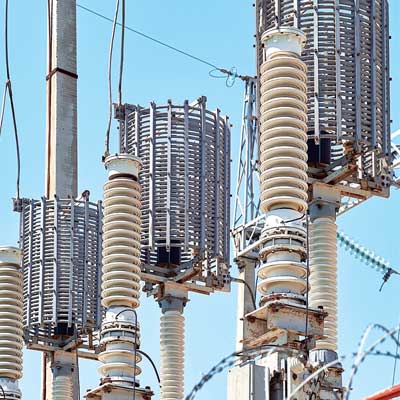Tight lending and enforced monetary control on power machineries in the states has reduced legacy dues. Better enforcement through policy seems to be reducing lending risks as well, even as the renewable sector stabilises, finds E Jayashree Kurup.When REC (formerly Rural Electrification Corporation), one of the major lenders to the power sector, declared the highest ever quarterly and yearly profit at Rs 30 billion and Rs 110.55 million respectively, it was mirroring what has happened in the power sector in India. Enhancement of renewable power generation and discipline in financial management has been the hallmark of the power sector in the COVID and post-pandemic era. State power companies are now toeing the line of discipline. With states reporting total legacy dues of Rs 1,397.47 billion as on June 2022, the pandemic was just the proverbial straw on the camel’s back. The lockdown made it difficult to bill the consumer and with finances already at a precarious level, something drastic had to evolve. The centre stepped in through the major power sector lenders such as the Power Finance Corporation and REC to use resources to rein in the discoms and gencos as well as the states and union territories.So what are the risks that lenders traditionally faced?Poor managementTraditionally open to political largesse and therefore weak management of finances, power generation, distribution and transmission were all poorly managed for decades. The first step was to put a halt to the ballooning payment dues. Only policy interventions could have done this job of addressing the legacy dues and resetting a disciplined borrowing schedule. The intervention came in the form of the revamped distribution sector scheme (RDSS) with an outlay of Rs.3,037.58 billion and estimated government budgetary support from the central government of `976.31 billion for five years from (FY 2021-22 to FY 2025-26). The scheme aimed to reduce the aggregate technical and commercial (AT&C) losses to 12-15 per cent at pan-India levels and reduce the average cost of supply (ACS) to average revenue realised (ARR) gap to zero by 2024-25.The scheme had two parts, to upgrade the distribution infrastructure and to enhance the smart metering to consumers. So far action plans and detailed project reports (DPRs) of 46 discoms (28 states/UTs) have been approved where 204.6 million pre-paid smart consumers meters, 5.4 million smart DT meters and 1.98 lakh smart feeder meters have been sanctioned. This financial stability helps lenders predict their business direction.The first step towards this streamlining was taken about a year earlier when the late payment surcharge rules (LPS) 2022 was announced by the centre. The REC disbursed to 19 states including the North Eastern region, Jammu & Kashmir and Ladakh as well as major states such as Uttar Pradesh, Rajasthan, Bihar and Tamil Nadu. The results are already showing.Significant achievementFrom the total legacy dues of Rs.1,397.47 billion in June 2022, 13 states have already paid a total amount of `591.74 billion in 10 EMIs (including prepayment and reconciliation). The legacy outstanding amount has been reduced to `805.73 billion. This is a significant achievement in itself. But, says REC CMD, Vivek Kumar Dewangan, “This policy has been path breaking and there has been an all-round upgrade. AT&C losses are down by 5 per cent, states have started pre-paying subsidies to the discoms and there has been drastic reduction in government dues.” This is very much a carrot and stick policy. Experts note that states have been adhering to the discipline, as all 10 EMIs have been paid on time with respect to legacy dues. As per LPS Rules 2022, in case of non-payment of dues by the distribution licensee or other user of transmission systems, even after two and a half months from presentation of bill by the generating company or transmission licensee or trading licensee, or in case of default in the payment of instalments fixed under these rules, the power supply to the defaulting entity shall be regulated. This is a significant clause as it puts a condition of commitment on the state power authorities. In case of default now, there are consequences of poor access to services. This works in favour of the lenders.Explains Ravinder Singh Dhillon, Chairman and Managing Director, Power Finance Corporation (PFC), “The scheme has resulted in more disciplined payment behaviour by discoms. Now, if they are not able to pay, there will be a repercussion because of the regulation, and the discom would not be able to purchase power. So now, discoms are trying to improve the payment cycle.”Statements for such defaulting discoms are published on a daily basis on the portal payment ratification and analysis in power procurement for bringing transparency in invoicing of generators (PRAAPTI). This has had its required impact in that the states have been regularly paying the EMIs and subsidies. Such stringent measures linked to finance were required to rein in the state power infrastructure. Now with a consequence of reduced supply for poor payment records, there are fewer challenges of recovery for the lenders. Better financial management leads to better quality of power, at reduced rates to the consumer.“Ultimately, the discoms have to pay the generators, and if you see the past trend, the genco dues were around `1.38 trillion and the receivables for the discoms were around `600-700 billion for the state government dues, and around `750 billion was the subsidy that they had to receive. So, when the discoms were not getting payment from the state governments, they were not able to pay the gencos. Under RDSS, we are trying to give a trajectory for the liquidation of state government dues and one for the liquidation of subsidies,” Dhillon explains.Powering the shiftPower financing is shifting from a piecemeal format to a more modern total expenditure (Totex) format. A single agency is contracted to supply, maintain and operate the meter networks services to the distribution company. The contracting agency makes the capital and operating investments under the design, build, fund, own, operate and transfer (DBFOOT) model. It will be paid a portion of its capital expenditure initially and the remaining payment during the O&M period. So what does this mean to lenders? They have a better economic landscape to work in and with regular receivables can continue to push the boundaries of efficiencies in generation and distribution.However, in line with the country’s green mission, approximately 30 per cent of all India installed generation capacity is from renewable energy sources (as on 31 December 2022, as per the Central Electricity Authority report). This renewable energy is a very different system from the traditional thermal or hydro power projects. The PFC currently funds about 16 per cent (20 GW) addition to the country's renewable capacity.Challenges of funding REFrom a lender's perspective, the risks associated with funding renewable energy production include land acquisition, availability of evacuation infrastructure, technology and payment risks. However, solar and wind energy projects have gained maturity, leading to competitive costs and lower technology risk. Also, being short gestation projects (nine months to two years), construction and implementation risk is also lower. The solar projects have a gestation period of 25 years. But the PFC loans are for 15-18 years, and therefore reduce risk to the lenders. The renewable energy projects of PFC have registered a CAGR of 32 per cent in the last five years.REC has lent `15 trillion just to renewable energy, which is 6.8 per cent of its loan portfolio. While 90 per cent of traditional lending was to state governments, with no defaults, the green lending has been to the private sector in a large way. REC expects this green lending to go up to 33 per cent by 2030. However, with green funds through the external commercial borrowing route having better terms, the lenders are quite happy to do so.The lending has been diversified into components for renewable energy storage systems, including imported equipment, decarbonising the loan books by leading to coal based units to become compliant with emission norms and switching to biomass pellets to replace coal. It is also lending to green ports like Kochi to become a trans-shipment base for hydrogen and ammonia.The execution environment has seen tremendous improvement in the past few years, with the implementation of projects through solar parks and special investment regions, which aid in providing land, clearances, approvals, project linkages, evacuation infrastructure etc. in a streamlined manner.Manufacturing & energy storageEven as government intervention has given the fillip to the power sector, there is further need for improvement of this relatively newer sector. India needs to enhance its storage and manufacturing capabilities. With renewable energy accounting for more and more of India’s power generation, it can no longer afford to keep importing solar panels and other inputs from China.Indian manufacturing units are currently being offered production linked incentives (PLI) so that they can claim incentives on incremental sales of products manufactured domestically. This will boost the Make in India objective and create a network of companies that can manufacture the required capacities locally.In line with this changing ecosystem, the lenders have to be nimble in adjusting to the requirements of newer technologies. As they stabilise, the risks will be lower. By 2030 almost 10 GW of storage capacity of renewable energy has to be made available. This is work in progress, with many initiatives in this direction. This includes a `40 billion allocation for enhancing storage capacities. Rooftop solar and green hydrogen and ammonia are still nascent, but have a huge renewable generation capacity. Storage is still a new segment and needs a lot of research and development.With the help of various government reforms to improve the health of discoms such as LPS, the payment timelines have seen a significant improvement. The legacy dues have reduced and better financial discipline can be expected going forward. However, the challenges of dealing with new renewable technologies and newer players pose a significant risk. This is mitigated by the fact that these are much lower gestation projects compared to traditional power infrastructure.Lenders and service providers have been pushed by policies to work towards better returns and efficient functioning. In an ecosystem that makes borrowers accountable and liable to be called out for default, the lending risks become lower. The final tally of the impact of the measures of the past two years is still being compiled. Prima facie, the tallies are positive. Any blips or state variances will only come to light after the numbers are released.(E Jayashree Kurup is Senior Editor, ASAPP Media; and Director, Real Estate & Cities, Wordmeister Editorial Services)


















